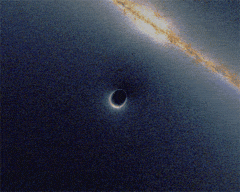
Back Swartkolk Afrikaans Schwarzes Loch ALS Forato negro AN कृष्ण विवर ANP ثقب أسود Arabic محفر كحل ARY ثقب أسود ARZ কৃষ্ণগহ্বৰ Assamese Furacu negru AST Qara dəlik Azerbaijani
A black hole is a region of spacetime wherein gravity is so strong that no matter or electromagnetic energy (e.g. light) can escape it.[2] Albert Einstein's theory of general relativity predicts that a sufficiently compact mass can deform spacetime to form a black hole.[3][4] The boundary of no escape is called the event horizon. A black hole has a great effect on the fate and circumstances of an object crossing it, but it has no locally detectable features according to general relativity.[5] In many ways, a black hole acts like an ideal black body, as it reflects no light.[6][7] Quantum field theory in curved spacetime predicts that event horizons emit Hawking radiation, with the same spectrum as a black body of a temperature inversely proportional to its mass. This temperature is of the order of billionths of a kelvin for stellar black holes, making it essentially impossible to observe directly.
Objects whose gravitational fields are too strong for light to escape were first considered in the 18th century by John Michell and Pierre-Simon Laplace.[8] In 1916, Karl Schwarzschild found the first modern solution of general relativity that would characterise a black hole. Due to his influential research, the Schwarzschild metric is named after him. David Finkelstein, in 1958, first published the interpretation of "black hole" as a region of space from which nothing can escape. Black holes were long considered a mathematical curiosity; it was not until the 1960s that theoretical work showed they were a generic prediction of general relativity. The discovery of neutron stars by Jocelyn Bell Burnell in 1967 sparked interest in gravitationally collapsed compact objects as a possible astrophysical reality. The first black hole known was Cygnus X-1, identified by several researchers independently in 1971.[9][10]
Black holes of stellar mass form when massive stars collapse at the end of their life cycle. After a black hole has formed, it can grow by absorbing mass from its surroundings. Supermassive black holes of millions of solar masses (M☉) may form by absorbing other stars and merging with other black holes, or via direct collapse of gas clouds. There is consensus that supermassive black holes exist in the centres of most galaxies.
The presence of a black hole can be inferred through its interaction with other matter and with electromagnetic radiation such as visible light. Any matter that falls toward a black hole can form an external accretion disk heated by friction, forming quasars, some of the brightest objects in the universe. Stars passing too close to a supermassive black hole can be shredded into streamers that shine very brightly before being "swallowed."[11] If other stars are orbiting a black hole, their orbits can be used to determine the black hole's mass and location. Such observations can be used to exclude possible alternatives such as neutron stars. In this way, astronomers have identified numerous stellar black hole candidates in binary systems and established that the radio source known as Sagittarius A*, at the core of the Milky Way galaxy, contains a supermassive black hole of about 4.3 million solar masses.
- ^ Oldham, L. J.; Auger, M. W. (March 2016). "Galaxy structure from multiple tracers – II. M87 from parsec to megaparsec scales". Monthly Notices of the Royal Astronomical Society. 457 (1): 421–439. arXiv:1601.01323. Bibcode:2016MNRAS.457..421O. doi:10.1093/mnras/stv2982. ISSN 0035-8711. S2CID 119166670.
- ^ Wald 1984, pp. 299–300
- ^ Wald, R. M. (1997). "Gravitational Collapse and Cosmic Censorship". In Iyer, B. R.; Bhawal, B. (eds.). Black Holes, Gravitational Radiation and the Universe. Dordrecht: Springer. pp. 69–86. arXiv:gr-qc/9710068. doi:10.1007/978-94-017-0934-7. ISBN 978-9401709347.
- ^ Overbye, Dennis (8 June 2015). "Black Hole Hunters". NASA. Archived from the original on 9 June 2015. Retrieved 8 June 2015.
- ^ Hamilton, A. "Journey into a Schwarzschild black hole". jila.colorado.edu. Archived from the original on 3 September 2019. Retrieved 28 June 2020.
- ^ Schutz, Bernard F. (2003). Gravity from the ground up. Cambridge University Press. p. 110. ISBN 978-0-521-45506-0. Archived from the original on 2 December 2016.
- ^ Davies, P. C. W. (1978). "Thermodynamics of Black Holes" (PDF). Reports on Progress in Physics. 41 (8): 1313–1355. Bibcode:1978RPPh...41.1313D. doi:10.1088/0034-4885/41/8/004. S2CID 250916407. Archived from the original (PDF) on 10 May 2013.
- ^ Montgomery, Colin; Orchiston, Wayne; Whittingham, Ian (2009). "Michell, Laplace and the origin of the black hole concept" (PDF). Journal of Astronomical History and Heritage. 12 (2): 90–96. Bibcode:2009JAHH...12...90M. doi:10.3724/SP.J.1440-2807.2009.02.01. S2CID 55890996.
- ^ Webster, B. Louise; Murdin, Paul (1972), "Cygnus X-1—a Spectroscopic Binary with a Heavy Companion?", Nature, 235 (5332): 37–38, Bibcode:1972Natur.235...37W, doi:10.1038/235037a0, S2CID 4195462
- ^ Bolton, C. T. (1972), "Identification of Cygnus X-1 with HDE 226868", Nature, 235 (5336): 271–273, Bibcode:1972Natur.235..271B, doi:10.1038/235271b0, S2CID 4222070
- ^ Clery D (2020). "Black holes caught in the act of swallowing stars". Science. 367 (6477): 495. Bibcode:2020Sci...367..495C. doi:10.1126/science.367.6477.495. PMID 32001633. S2CID 210984462.

